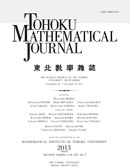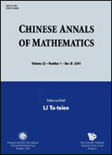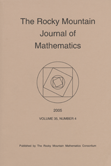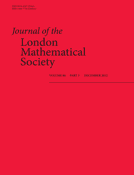
INDIANA UNIVERSITY MATHEMATICS JOURNAL
Scope & Guideline
Unveiling New Methodologies in Mathematical Research
Introduction
Aims and Scopes
- Analysis and Partial Differential Equations:
The journal extensively covers topics related to the analysis of partial differential equations (PDEs), exploring their solutions, stability, and qualitative properties. This includes research on nonlinear equations, asymptotic behavior, and regularity issues. - Geometric Analysis and Topology:
Research in geometric analysis and topology is a significant focus, with papers discussing manifolds, curvature, and various geometric structures, alongside topological aspects that influence mathematical phenomena. - Algebra and Representation Theory:
The journal includes studies on algebraic structures, particularly in relation to representation theory, which investigates how algebraic objects can be represented through linear transformations. - Probability and Stochastic Processes:
There is a consistent emphasis on probability theory and stochastic processes, investigating random phenomena and their mathematical foundations, including applications to various fields. - Mathematical Physics:
The intersection of mathematics with physical theories is explored, particularly through the lens of mathematical rigor applied to physical models, including fluid dynamics and quantum mechanics. - Numerical Analysis and Computational Methods:
Papers often focus on numerical methods for solving mathematical problems, emphasizing algorithm development, error analysis, and applications in computational mathematics.
Trending and Emerging
- Nonlinear Dynamics and Stability Analysis:
An increasing number of papers focus on nonlinear dynamics, particularly in the context of stability analysis for various mathematical models, including fluid dynamics and wave equations. - Machine Learning and Mathematical Applications:
There is a growing trend towards integrating machine learning techniques with mathematical research, exploring applications in optimization, data analysis, and algorithm development. - Mathematical Biology and Ecology:
Research at the intersection of mathematics and biology is gaining traction, with studies addressing mathematical models of biological processes, population dynamics, and ecological modeling. - Quantum Mathematics and Noncommutative Geometry:
Recent publications indicate a rising interest in quantum mathematics, particularly noncommutative geometry and its applications to physics and algebra, reflecting broader interdisciplinary connections. - Fractional Calculus and Applications:
The exploration of fractional calculus is becoming more prominent, with papers investigating its applications in various fields, including physics and engineering, highlighting its mathematical significance.
Declining or Waning
- Classical Algebraic Geometry:
The focus on classical algebraic geometry has waned, with fewer papers exploring traditional topics such as varieties, schemes, and classical constructions, indicating a shift towards more contemporary approaches. - Elementary Number Theory:
Research in elementary number theory has decreased, as the journal has increasingly prioritized more advanced mathematical topics and methodologies, leading to fewer submissions in this area. - Combinatorial Geometry:
There has been a noticeable reduction in the number of papers addressing combinatorial geometry, possibly reflecting a broader trend in the mathematical community towards other areas of research.
Similar Journals

MANUSCRIPTA MATHEMATICA
Cultivating Collaboration Among Mathematicians.MANUSCRIPTA MATHEMATICA is an esteemed journal in the field of mathematics, published by Springer Heidelberg. Since its inception in 1969, this journal has served as a pivotal platform for disseminating high-quality research in a variety of mathematical disciplines, with a commitment to advancing knowledge and fostering collaboration among mathematicians. The journal holds a commendable impact factor and is ranked within the Q2 category for Mathematics (miscellaneous) in 2023, placing it favorably among its peers in terms of academic influence. Although open access options are not available, its rigorous peer-review process ensures that published articles maintain the highest academic standards. With a wide scope covering significant areas of general mathematics, MANUSCRIPTA MATHEMATICA not only caters to researchers and professionals seeking innovative insights but also serves as a valuable resource for students eager to deepen their understanding of mathematical theories and applications. For those looking to contribute to or stay informed about advancements in this dynamic field, the journal remains a crucial resource for literature and discourse.

Pure and Applied Mathematics Quarterly
Shaping the Future of Mathematics with Every IssuePure and Applied Mathematics Quarterly is a prestigious journal published by INT PRESS BOSTON, INC, focusing on the diverse and evolving field of mathematics. Since its inception in 2007, this journal has grown significantly, currently holding a Q1 ranking in the Mathematics (Miscellaneous) category for 2023, positioning it among the leading publications in the discipline. With a commitment to publishing high-quality research, Pure and Applied Mathematics Quarterly fosters innovation and dialogue within the mathematical community by providing a platform for theoretical advancements and practical applications. The journal remains accessible to researchers and professionals through its ISSN 1558-8599 and E-ISSN 1558-8602, although it does not currently offer open access. As a vital resource for mathematicians, educators, and students, this journal endeavors to expand the frontiers of mathematical knowledge and contribute to the academic dialogue surrounding this fundamental science.

Forum of Mathematics Sigma
Shaping the future of mathematics through rigorous scholarship.Forum of Mathematics Sigma is a premier open access journal published by Cambridge University Press that has been at the forefront of mathematical research since its inception in 2013. With a strong emphasis on advancing the fields of mathematics, the journal consistently achieves Q1 rankings across multiple categories, including Algebra and Number Theory, Analysis, and Computational Mathematics. This distinction highlights its impact and relevance within the scholarly community. The journal prides itself on providing a platform for innovative research, fostering collaboration among researchers and practitioners across various mathematical disciplines. Open access publication ensures that cutting-edge findings are widely available to readers globally, enhancing the dissemination of knowledge. With an address in the heart of Cambridge, England, Forum of Mathematics Sigma is dedicated to promoting high-quality research and making significant contributions to the development of mathematics.

TOHOKU MATHEMATICAL JOURNAL
Advancing the Frontiers of Mathematical KnowledgeTOHOKU MATHEMATICAL JOURNAL, published by TOHOKU UNIVERSITY, is a distinguished academic journal committed to the advancement of mathematical research. Established in 1949, the journal has sustained a long-standing tradition of disseminating high-quality, peer-reviewed articles that contribute significantly to various branches of mathematics. With its scope encompassing a broad range of topics within the field, TOHOKU MATHEMATICAL JOURNAL aims to foster intellectual exchange and innovation among mathematicians worldwide. Though currently not an open-access publication, it is indexed in Scopus, holding a respectable Q2 ranking in the miscellaneous mathematics category as of 2023, which signifies its relevance and influence in the academic community. Researchers, professionals, and students alike will find valuable insights and contemporary developments that reflect the journal's dedication to excellence in mathematical scholarship.

CUBO-A Mathematical Journal
Unlocking New Perspectives in MathematicsCUBO-A Mathematical Journal, published by the Department of Mathematics and Statistics at Universidad de La Frontera in Chile, stands as a significant Open Access resource in the field of mathematics since its inception in 2011. With an ISSN of 0716-7776 and an E-ISSN of 0719-0646, this journal invites submissions that explore a wide spectrum of mathematical disciplines, including Algebra, Number Theory, Analysis, Geometry, Topology, and Logic. Although currently positioned in the Q4 category across various mathematical domains and registered at Rank #223/399 in General Mathematics in Scopus, CUBO serves as a valuable platform for emerging researchers and practitioners to disseminate their findings. Operating under a continuous commitment to accessibility, CUBO fosters an inclusive academic environment that supports the exchange of innovative ideas vital to advancing mathematics. The journal's target audience encompasses a diverse community of researchers, professionals, and students eager to participate in the expanding dialogue within mathematical sciences.

CHINESE ANNALS OF MATHEMATICS SERIES B
Empowering Researchers through Diverse Mathematical DiscoursesCHINESE ANNALS OF MATHEMATICS SERIES B, published by Shanghai Scientific Technology Literature Publishing House, is a prominent journal dedicated to fostering research and development in the field of mathematics. With an ISSN of 0252-9599 and an E-ISSN of 1860-6261, this journal provides a platform for the dissemination of innovative mathematical theories and methodologies. As of 2023, it is categorized within the Q4 quartile in *Applied Mathematics* and has achieved a commendable Q3 rank in *Mathematics (miscellaneous)*, emphasizing its growing influence in academia. Despite not being an open-access publication, it serves as a valuable resource for researchers, professionals, and students seeking to explore diverse mathematical topics, particularly from a unique regional perspective. The journal's extensive publication history—from 1980 and continuing to 2024—demonstrates a longstanding commitment to advancing mathematical knowledge and providing insights into various disciplines related to mathematics.

ANNALI DI MATEMATICA PURA ED APPLICATA
Pioneering Insights in Pure and Applied MathematicsANNALI DI MATEMATICA PURA ED APPLICATA is a prestigious journal published by Springer Heidelberg, focusing on the field of Applied Mathematics. With a rich history dating back to its initial publication stages from 1858, this journal continues to serve as a vital platform for researchers and professionals seeking to disseminate high-quality, peer-reviewed research. The journal's strong reputation is reflected in its Q1 ranking in Applied Mathematics and its Scopus rank of #335 out of 635, placing it in the 47th percentile, showcasing its impact in the field. Although it is not an open-access journal, it provides exclusive insights and advancements in mathematical applications, allowing academics to explore innovative methodologies and theoretical developments. The combination of its long-standing tradition and contemporary relevance makes ANNALI DI MATEMATICA PURA ED APPLICATA an essential resource for scholars and students looking to deepen their understanding of mathematics and its practical applications.

ROCKY MOUNTAIN JOURNAL OF MATHEMATICS
Championing Rigorous Research in MathematicsROCKY MOUNTAIN JOURNAL OF MATHEMATICS, published by the Rocky Mountain Math Consortium, serves as a critical platform for researchers and practitioners in the field of mathematics since its inception in 1971. With a notable presence in the academic community, this journal covers a broad spectrum of mathematical disciplines, positioning itself in the Q2 category for Mathematics (miscellaneous) as of 2023. Despite being a subscription-based journal, it is recognized for its rigorous peer-review process and contributions to theoretical and applied mathematics, helping to advance knowledge and foster collaboration among mathematicians. The journal's ISSN number is 0035-7596 and its E-ISSN is 1945-3795, reflecting its commitment to accessibility and dissemination of high-quality research. Based in Tempe, Arizona, at Arizona State University, the journal continues to play an important role in shaping contemporary mathematical discourse through well-researched articles and innovative studies, aiming to bridge gaps between various mathematical subfields and engage a diverse audience, including students and established researchers alike.

PUBLICATIONES MATHEMATICAE DEBRECEN
Connecting Scholars through High-Quality Mathematical ResearchPublicationes Mathematicae Debrecen is a renowned international journal published by the University of Debrecen, Institute of Mathematics, situated in Hungary. This journal, with both ISSN 0033-3883 and E-ISSN 2064-2849, has established itself in the field of mathematics since its inception, with coverage extending from 1997 to 2024. Recognized for its rigorous academic standards, it currently holds a Q3 ranking in the mathematics (miscellaneous) category for 2023 and ranks at the 42nd percentile among general mathematics journals in Scopus. Publicationes Mathematicae Debrecen aims to disseminate high-quality research across various areas of mathematics, contributing to the advancement of knowledge and practice in this dynamic field. Although it is not an open-access journal, its readers can access a wealth of scholarly work that addresses both theoretical and applied mathematical issues, making it an invaluable resource for researchers, professionals, and students alike.

JOURNAL OF THE LONDON MATHEMATICAL SOCIETY-SECOND SERIES
Connecting Scholars Through Groundbreaking Mathematical ResearchJOURNAL OF THE LONDON MATHEMATICAL SOCIETY-SECOND SERIES, published by Wiley, stands as a premier publication in the field of mathematics, particularly recognized for its contributions to general mathematics and its ability to shape contemporary mathematical discourse. With an impact factor that reflects its high citation rate and academic influence, this journal has secured a prestigious Q1 ranking in the Mathematics (miscellaneous) category as of 2023. Encompassing a rich history from its inception in 1926 through various publication phases until 2024, it continues to attract and disseminate innovative research, serving as a vital resource for scholars, practitioners, and students alike. Although it does not currently offer open access options, the journal's commitment to advancing mathematical knowledge makes it an essential source for the latest developments in the discipline. For those engaged in mathematical research, insights from the JOURNAL OF THE LONDON MATHEMATICAL SOCIETY-SECOND SERIES are invaluable in fostering a deeper understanding and sparking new ideas within the mathematical community.